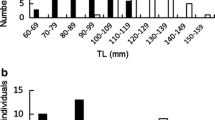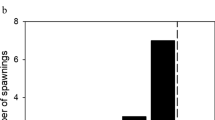Abstract
The timing of arrival to breeding areas can have profound effects on reproductive success. Under some conditions (restricted breeding seasons and mating systems characterized by a longer period of mating among males than females), the maximization of mating opportunities by males theoretically selects for the earlier arrival of males than females (a phenomenon called protandry). This study quantifies the relationship between the arrival timing and spawning success of male kokanee (non-anadromous Oncorhynchus nerka). The spawning behavior of kokanee was observed in a large pen and the spawning success of each male was estimated as the number of spawning events he participated in. A male's spawning success depended primarily on his success at pairing with and mate-guarding females, and less on participation in spawning events while unpaired. Males who paired earlier in the season had higher spawning success than males who paired later in the season because they experienced more opportunities to pair with new females. Among males who eventually paired (some males never did), arriving early was correlated with pairing early. However, selection for protandry was weak, largely because early arrival did not guarantee that a male would pair. Pre-spawning waiting by females also weakened the correlation between arrival day and pairing day. The random probability of pairing with respect to arrival day and pre-spawning waiting by females likely explains the weak selection for protandry in kokanee and the low amount of protandry observed in other sockeye salmon (anadromous O. nerka) populations.






Similar content being viewed by others
References
Chebanov NA (1997) Role of the "prior resident" effect in formation of the dominance-subordination relations and determination of the reproductive success values in Pacific salmons. J Ichthyol 37:110–115
Chebanov NA, Varnavskaya NV, Varnavskiy VS (1983) Effectiveness of spawning of male sockeye salmon, Oncorhynchus nerka (Salmonidae), of differing hierarchical rank by means of genetic-biochemical markers. J Ichthyol 23:51–55
Cueva del Castillo R, Núñez-Fárfán J (1999) Sexual selection on maturation time and body size in Sphenarium purpurascens (Orthoptera: Pyrgomorphidae): correlated response to selection. Evolution 53:209–215
Fleming IA, Gross MR (1994) Breeding competition in a Pacific salmon (Coho: Oncorhynchus kisutch): measures of natural and sexual selection. Evolution 48:637–657
Foote CJ (1990) An experimental comparison of male and female spawning territoriality in a Pacific salmon. Behaviour 115:283–314
Foote CJ, Larkin PA (1988) The role of male choice in the assortative mating of anadromous and non-anadromous sockeye salmon (Oncorhynchus nerka). Behaviour 106:43–62
Foote CJ, Brown GS, Wood CC (1997) Spawning success of males using alternative mating tactics in sockeye salmon, Oncorhynchus nerka. Can J Fish Aquat Sci 54:1785–1795
Gross MR (1985) Disruptive selection for alternative life histories in salmon. Nature 313:47–48
Hastings J (1989) Protandry in western cicada killer wasps, (Sphecius grandis, Hymenoptera: Sphecidae): an empirical study of emergence time and mating opportunity. Behav Ecol Sociobiol 25:255–260
Healey MC, Prince A (1998) Alternative tactics in the breeding behaviour of male coho salmon. Behaviour 135:1099–1124
Hendry AP, Berg OK, Quinn TP (1999) Condition dependence and adaptation-by-time: breeding date, life history, and energy allocation within a population of salmon. Oikos 85:499–514
Iwasa Y, Odendaal JF, Murphy DD, Ehrlich PR, Launer AE (1983) Emergence patterns in male butterflies: a hypothesis and a test. Theor Popul Biol 23:363–379
Lande R, Arnold SJ (1983) The measurement of selection on correlated characters. Evolution 37:1210–1226
Maekawa K, Onozato H (1986) Reproductive tactics and fertilization success of mature male Miyabe charr, Salvelinus malma miyabei. Environ Biol Fish 15:119–129
Mathisen OA (1962) The effect of altered sex ratios on the spawning of red salmon. Koo, TSY (ed) Studies of Alaska red salmon. Univ Wash Publ Fish New Ser 1:137–248
McPhee MV, Quinn TP (1998) Factors affecting the duration of nest defense and reproductive lifespan of female sockeye salmon, Oncorhynchus nerka. Environ Biol Fish 51:369–375
Mjølnerød IB, Fleming IA, Refseth UH, Hindar K (1998) Mate and sperm competition during multiple-male spawnings of Atlantic salmon. Can J Zool 76:70–75
Morbey Y (2000) Protandry in Pacific salmon. Can J Fish Aquat Sci 57:1252–1257
Morbey YE (2002a) Protandry models and their application to salmon. Behav Ecol 13:337–343
Morbey YE (2002b). The mate-guarding behaviour of male kokanee (Oncorhynchus nerka). Behaviour 139:507–528
Morbey YE, Ydenberg RC (2001) Protandrous arrival timing to breeding areas: a review. Ecol Lett 4:663–673
Morbey YE, Ydenberg RC (2003) Timing games in the reproductive phenology of female Pacific salmon (Oncorhynchus spp.). Am Nat 161:284–298
Perrin CJ, Irvine JR (1990) A review of survey life estimates as they apply to the area-under-the-curve method for estimating the spawning escapement of Pacific salmon. Can Tech Rep Fish Aquat Sci 1733
Quinn TP, Foote CJ (1994) The effects of body size and sexual dimorphism on the reproductive behaviour of sockeye salmon, Oncorhynchus nerka. Anim Behav 48:751–761
Quinn TP, Adkison MD, Ward MB (1996) Behavioral tactics of male sockeye salmon (Oncorhynchus nerka) under varying operational sex ratios. Ethology 102:304–322
Schluter D, Nychka D (1994) Exploring fitness surfaces. Am Nat 143:597–616
Schroder SL (1982) The influence of intrasexual competition on the distribution of chum salmon in an experimental stream. In: Brannon EL, Salo EO (eds) Proceedings of the Salmon and Trout Migratory Symposium, 1981. University of Washington, Seattle, Wash., pp 275–285
Wiklund C, Fagerström T (1977) Why do males emerge before females? A hypothesis to explain the incidence of protandry in butterflies. Oecologia 31:153–158
Acknowledgements
I thank Jessica Macdonald and Tasha Smith for their enthusiastic help with the field work, and John Bell, Jay Hammond, Murray Pearson (all from the B.C. Ministry of Environment), and the crew from the Kootenay Trout Hatchery for logistical support. Bernie Crespi, Larry Dill, Andrew Hendry, Tom Quinn, Bernie Roitberg, Ron Ydenberg, and three anonymous reviewers provided useful advice on how to improve the manuscript. Financial support was provided through fellowships from the Garfield Weston Foundation and B.C. Packers, Ltd., the Natural Science and Engineering Research Council of Canada (NSERC), and Simon Fraser University, and an NSERC operating grant to Ron Ydenberg. The experimental protocol was approved by Simon Fraser University's Animal Care Committee.
Author information
Authors and Affiliations
Corresponding author
Additional information
Communicated by M. Abrahams
Rights and permissions
About this article
Cite this article
Morbey, Y.E. Pair formation, pre-spawning waiting, and protandry in kokanee, Oncorhynchus nerka . Behav Ecol Sociobiol 54, 127–135 (2003). https://doi.org/10.1007/s00265-003-0606-3
Received:
Revised:
Accepted:
Published:
Issue Date:
DOI: https://doi.org/10.1007/s00265-003-0606-3




